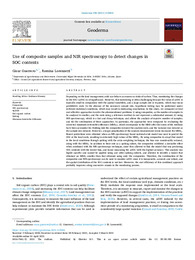Resumen :
Depending on the land management, soils can behave as sources or sinks of carbon. Thus, monitoring the changes
in the SOC (ΔSOC) is of significance. However, this monitoring is often challenging because the value of ΔSOC is
typically small in comparison with the spatial variability, and a large sample size is required, which may incur
prohibitive costs. In the absence of the necessary sample size, hypothesis testing may be performed under
deficient statistical conditions, which may result in misleading conclusions. In this study, we compared several
cost-effective approaches to solve the aforementioned problems: i) using composites, as the number of samples to
be analysed is smaller, and the costs using a reference method do not represent a substantial amount; ii) using
NIR spectroscopy, which is a fast and cheap technique, and allows the analysis of massive number of samples;
and iii) the combination of these approaches. In particular, the approaches were compared by evaluating the
corrected minimum detectable difference (MDDC), which corresponds to the MDD after the errors of the methods
have been accounted for. Bulking into the composites reduced the analysis costs, and the variance was reduced as
the sample size reduced. However, a larger penalisation of the random measurement errors increased the MDDC.
Biased predictions were obtained when an NIR spectroscopy based national scale model was used to predict the
SOC at the local scale, resulting in extremely high values of the MDDC. By using composites to adapt that model
to the local conditions through spiking with the extra-weighting technique, the bias was considerably reduced,
along with the MDDC. In addition to their role as a spiking subset, the composites exhibited a desirable effect
when combined with the NIR spectroscopy technique, since they allowed to find the model that was predicting
SOC contents with the lowest bias, and hence measuring the ΔSOC with the highest accuracy. This analysis was
highly specific and cannot be applied using any other spiking subsets, and allowed to identify a model that
obtained an MDDC smaller than that obtained using only the composites. Therefore, the combination of the
composites and NIR spectroscopy can be used to monitor ΔSOC since it is inexpensive, accurate and robust, and
the spatial distribution of the SOC contents is not lost. Moreover, the cost efficiency of this combined approach
probably improves along successive rounds in the monitoring process.
|
 La licencia se describe como: Atribución-NonComercial-NoDerivada 4.0 Internacional.
La licencia se describe como: Atribución-NonComercial-NoDerivada 4.0 Internacional.
.png)
